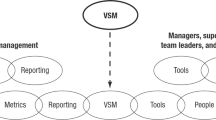Abstract
This paper discusses the scheduling of operators on work elements in manufacturing environments where lean principles are adopted. Our experience with the industry revealed that the practice of lean manufacturing in organizations that manufacture oversized products, such as buses, aircrafts and locomotives differs from other organizations. The most obvious two differences are: the longer Takt times (average time between demands); and the fact that the work-stations are mainly placed in various locations inside/around the product and the operators can carryout activities in parallel in these work stations. Since the demand for the large products is considerably low, Takt time (average time between demands) is usually in the orders of hours. As a result, a product undergoes several modifications during a Takt time. The assembly process of the oversized products involves coordinated work of a number of tasks. While some of the tasks have strict precedence relationship with other activities, the others can be performed simultaneously. In this context, our problem is to assign N different operators to M different tasks with two alternative objectives; minimizing the discrepancies between the operators’ workloads and minimizing the number of operators used. The main constraint is to complete all the tasks within a given Takt time. We modeled the problem under both identical operator and non-identical operator assumptions. Various sensitivity analyses are discussed and the several examples are provided.
Access this chapter
Tax calculation will be finalised at checkout
Purchases are for personal use only
Preview
Unable to display preview. Download preview PDF.
Similar content being viewed by others
References
Boysen, N., Fliedner, M., Scholl, A. (2007): A classification of assembly line balancing problems, European Journal of Operational Research, Vol. 183, No. 2, pp. 674-693.
Bukchin, J., Masin, M. (2004): Multi-objective design of team oriented assembly systems, European Journal of Operational Research, Vol. 156, pp. 326-352
Bukchin, J., Darel, E., Rubinovitz, J, (1997): Team-oriented assembly system design: A new approach, International Journal of Production Economics, Vol. 51, pp. 47-57.
Chen, Z-L., Powell, W. B. (2003): Exact algorithms for scheduling multiple families of jobs on parallel machines, Naval Research Logistics, Vol. 50, No. 7, pp.823-840
Dastidar, S. G., Nagi, R. (2007): Batch splitting in an assembly scheduling environment, Int. Journal of Production Economics, Vol. 105, pp. 372-384.
Gao, C., Johnson, E., Smith, B. (2009): Integrated Airline Fleet and Crew Robust Planning, Transportation Science, Vol. 43, No. 1, pp. 2-16.
Koulamas, C., Kyparisis, G. J. (2008): Single-machine scheduling problems with past-sequence-dependent setup times, European Journal of Operational Research, Vol. 187, No. 3, pp. 1045-1049.
Laporte, G., Gendreau, M., Potvin, J-Y. (2000): Classical and Modern Heuristics for the Vehicle Routing Problem, International Transactions in Operational Research, Vol. 7, pp. 285-300.
Li, K., Yang, S-L. (2009): Non-identical Parallel-machine Scheduling Research with Minimizing Total Weighted Completion Times: Models, Relaxations and Algorithms, Applied Mathematical Modeling, Vol. 33, pp. 2145-2158.
Linker, J. (2004): The Toyota Way: 14 Management Principles from the World’s Greatest Manufacturer, McGraw-Hill, New York.
Ropke, S., Cordeau, J. F. (2009): Branch and Cut and Price for the Pickup and Delivery Problem with Time Windows, Transportation Science, Vol. 43, No. 3, pp. 267-286.
Zhang, R., Young, Y-W., Kopfer, H. (2010): Heuristic-based truck scheduling for inland container transportation, OR Spectrum, Vol. 32, No. 3, pp. 787-808.
Author information
Authors and Affiliations
Editor information
Editors and Affiliations
Rights and permissions
Copyright information
© 2012 Springer-Verlag Berlin Heidelberg
About this paper
Cite this paper
Ertogral, F.K., Akgunduz, A. (2012). Operator Scheduling Under the Lean Manufacturing Principles in Over-Size Product Manufacturing Facilities. In: ElMaraghy, H. (eds) Enabling Manufacturing Competitiveness and Economic Sustainability. Springer, Berlin, Heidelberg. https://doi.org/10.1007/978-3-642-23860-4_101
Download citation
DOI: https://doi.org/10.1007/978-3-642-23860-4_101
Published:
Publisher Name: Springer, Berlin, Heidelberg
Print ISBN: 978-3-642-23859-8
Online ISBN: 978-3-642-23860-4
eBook Packages: EngineeringEngineering (R0)




